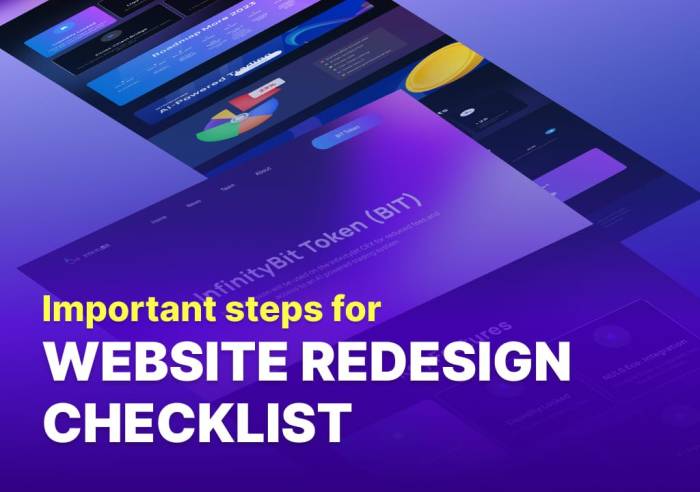Website Redesign Checklist: Embark on a journey to revamp your online presence with our comprehensive guide that ensures a sleek and efficient website redesign process.
Revamping your website is crucial for staying ahead in the digital game. Let’s dive into the essential steps to create a visually appealing and user-friendly online platform.
Importance of Website Redesign

When it comes to businesses, a website redesign is like giving your online presence a fresh coat of paint. It’s all about staying relevant, engaging your audience, and boosting those conversions, ya know?An outdated website can totally wreck the user experience. Slow load times, clunky navigation, and outdated design elements can send potential customers running faster than you can say “refresh.” And let’s not even get started on how it can tank your conversion rates.
Ain’t nobody got time for that!But fear not, my friends, because a modern and user-friendly website design can be a game-changer. Think sleek layouts, easy navigation, and mobile responsiveness that’ll have your visitors coming back for more. Plus, it shows that you’re on top of your game and ready to meet your customers’ needs. So, it’s time to hit refresh and give your website the makeover it deserves.
Planning the Redesign Process
When it comes to planning a website redesign, there are several key steps that need to be taken to ensure a successful project. Setting clear goals and objectives, as well as conducting a thorough audit of the current website, are crucial aspects of this process.
Setting Clear Goals and Objectives
To kick off the redesign process, it’s essential to establish clear goals and objectives for the project. This involves identifying what you want to achieve with the redesign, whether it’s improving user experience, increasing conversions, or updating the overall look and feel of the site. By setting specific, measurable, achievable, relevant, and time-bound (SMART) goals, you can keep the project on track and ensure that all stakeholders are aligned on the desired outcomes.
Conducting a Thorough Audit
Before diving into the redesign, it’s important to conduct a comprehensive audit of the current website. This involves reviewing the site’s content, design, functionality, and performance to identify areas for improvement. By analyzing user data, conducting usability testing, and gathering feedback from stakeholders, you can gain valuable insights into what is working well and what needs to be changed. This information will inform the redesign strategy and help prioritize tasks to achieve the desired goals and objectives.
Creating a Redesign Checklist

When redesigning a website, it’s crucial to have a detailed checklist to ensure nothing is overlooked. This checklist will help you stay organized and focused throughout the redesign process.
Importance of Responsive Design and Mobile Optimization
- Ensure your website is mobile-friendly to cater to the increasing number of users accessing websites on mobile devices.
- Implement responsive design to provide a seamless user experience across different screen sizes and devices.
- Optimize images and content for faster loading times on mobile devices.
- Test your website on various devices and browsers to ensure compatibility.
Prioritizing Content and Navigation
- Identify key content that aligns with your business goals and target audience needs.
- Organize content in a clear and intuitive manner to improve user navigation and engagement.
- Prioritize important information above the fold for easy access.
- Streamline navigation menus to reduce clutter and help users find information quickly.
User Experience and Design Elements
When it comes to creating a website that users will love, paying attention to design elements is key. A positive user experience can make or break the success of your site. From intuitive navigation to clear calls-to-action, every detail matters.
Key Design Elements for a Positive User Experience
- Responsive design that adapts to different screen sizes and devices.
- Visually appealing layout with easy-to-read fonts and colors.
- Fast loading times for images and multimedia content.
- Consistent branding elements throughout the site.
Importance of Intuitive Navigation and Clear Calls-to-Action
- Easy navigation helps users find what they’re looking for quickly and easily.
- Clear calls-to-action guide users towards desired actions, such as making a purchase or signing up for a newsletter.
- Well-placed buttons and links can significantly improve user engagement and conversion rates.
Optimizing Images and Multimedia Content for Faster Loading Times
- Compress images to reduce file sizes without sacrificing quality.
- Use lazy loading techniques to prioritize content above-the-fold for faster initial loading.
- Optimize videos and multimedia elements for speed and performance on all devices.
- Consider using CDN (Content Delivery Network) services to speed up delivery of content globally.
Testing and Launching the Redesigned Website: Website Redesign Checklist
When it comes to redesigning a website, testing and launching are crucial steps to ensure a successful transition. Testing the redesigned website across different devices and browsers is essential to guarantee a seamless user experience for all visitors. Usability testing helps identify any potential issues and allows for adjustments to be made before the launch. Finally, launching the redesigned website requires careful planning and monitoring to track its performance and address any issues that may arise.
Importance of Testing Across Devices and Browsers
- Ensure consistent user experience: Testing across various devices and browsers ensures that the website functions correctly and looks appealing on all platforms.
- Identify compatibility issues: Different devices and browsers may display the website differently, so testing helps identify and fix any compatibility issues.
- Optimize performance: Testing can reveal performance issues that may affect loading times or functionality, allowing for improvements to be made.
Conducting Usability Testing, Website Redesign Checklist
- Recruit testers: Select a diverse group of testers to represent the target audience and ask them to perform specific tasks on the website.
- Observe user behavior: Monitor how testers navigate the website, identify any usability issues, and gather feedback on their overall experience.
- Analyze results: Use the feedback from usability testing to make necessary adjustments to improve the user experience before the website launch.
Steps for Launching the Redesigned Website
- Perform final testing: Before launching, conduct one last round of testing to ensure all issues have been addressed and the website is ready for go-live.
- Set up analytics: Implement tracking tools to monitor website performance, user behavior, and traffic after the launch.
- Communicate the launch: Notify stakeholders, users, and the public about the redesigned website launch date and any changes they can expect.
- Monitor performance: Continuously monitor the website’s performance post-launch, addressing any issues that arise and making improvements as needed.






